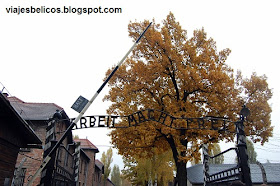After the Allied landings in France on June 6, 1944, the French
partisans began a series of actions such as the kidnapping of the SS Colonel Helmut Kampfe. The commander Diekman was sent to Oradour by false information which indicated that the colonel was held in the village. Feeling frustrated by being cheated, he ordered the murder of all the inhabitants of Oradour. 642 people died. All men were called and were taken taken to shelters where they were shot and burned. They also locked all the women and children in the church and set fire. Only six people survived the slaughter. The whole village disappeared. He
reconstructed the town around the original but keeping intact the scene of the
massacre, as a memorial and reminder of the horrors of war. Today, we can visit this ghost village and walk the streets as they were left after the June 10, 1944. This area is called the Village Martyr .
GETTING TO ORADOUR
- By car: click here to see the location. Roads in France are pretty good so it's the easiest way to arrive there.
- By train: from many cities you can take the TGV train to Limoges. From Limoges there are buses that leave leave you in half an hour to the Oradour's center of memory. You can check here the bus schedule.
- By air: Limoges has an airport. There are flights from Paris (Orly) with TwinJet (1h10min) or with Ryanair from London or Liverpool (1h40min) for low cost. Another option is to take a plane to Bordeaux . Once in Bordeaux there are direct trains to Limoges for about 30 euros ( 2h 30min ). You can check schedules and prices here . From Limoges to Oradour by bus (30min).
ACOMMODATION IN ORADOUR
If you want to spend the night in Oradour itself there is not much choice. You have the Glane Hotel beside the Village Martyr and the b&b Le Moulin de la Fauvette 2km. If you prefer to stay in Limoges there is a lot more variety . Also if you stay here you can go to the Resistance Museum .
If you want to spend the night in Oradour itself there is not much choice. You have the Glane Hotel beside the Village Martyr and the b&b Le Moulin de la Fauvette 2km. If you prefer to stay in Limoges there is a lot more variety . Also if you stay here you can go to the Resistance Museum .
THE CENTER OF THE MEMORY ORADOUR
Photo: Babsy
Location : here .
Official website: http://www.oradour.org
Openning hours: (last admission one hour before closing)
From 1 February to 28 February: 9:00-17:00
From 1 March to 15 May : 9:00-18:00
From 16 May to 15 September: 9:00-19:00
From 16 September to 31 October: 9:00-18:00
From 1 November to 15 December: 9:00-17:00
16 December to 31 January closed.
It opened in 1999. It is the main access to the Village Martyr. This is a museum created to commemorate both the history of Oradour as the German invasion of France. The permanent exhibition "Understanding Oradour" includes a campus tour through the years 1933-1944, the days June 9th and 10th 1944, the reconstruction of the town and a universal message.
THE VILLAGE MARTYR
The Village Martyr is the area which includes the ruins of the village. You enter through the Centre of the Memory but you can access the ruins without making the tour of the museum. The admission is free.
Photos: JLPC
After the ruins, we find the cemetery where they buried the victims of the slaughter. You can also visit a memorial located in an underground crypt with objects found in the ruins of the buildings. It is located at the entrance of the cemetery.
Source: http://www.oradour-souviens-toi.fr






































